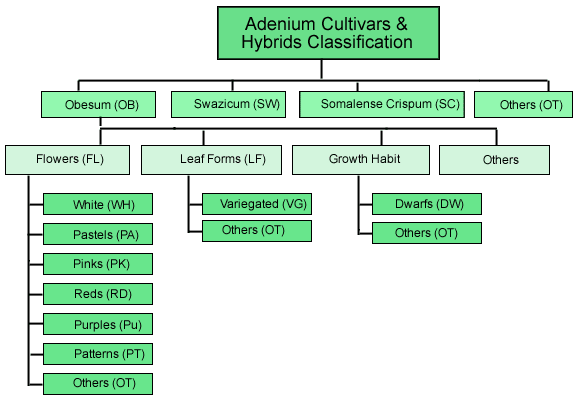ADENIUM CULTIVARS & HYBRIDS: CLASSIFICATION
The following classification system is a practical one and will work with all the cultivars that I am aware of at present. It envisages breaking up all Adenium selections into four broad GROUPS; these are based on species expression in the selection.The following classification system is a practical one and will work with all the cultivars that I am aware of at present. It envisages breaking up all Adenium selections into four broad GROUPS; these are based on species expression in the selection. Since the origin of most hybrids is not known, we can only do this based on outward characteristics or phenotype. Three main species are seen at work and all the others will fall into a "residual" fourth group.
Each GROUP has four CATEGORIES- these are determined by the main characteristic of horticultural interest for which the plant is being grown or can be differentiated by. For example, if an Adenium being grown for its flowers gives a variegated sport with equally good flowers, this variegated sport would still go into CATEGORY 2 - Leaf forms and not into CATEGORY 1- Flowers.
Each CATEGORY is subdivided into SUB-CATEGORIES which breaks up each characteristic that defines that category e.g. CATEGORY 1: FLOWERS (FL) is divided into seven SUB-CATEGORIES based on flower color.
This basic classification module is presented in the organization chart below.

| Group OB |
Category FL |
Sub-Category RD< |
Tag OB-FL-RD-213 |
The boxes above represent the Cultivar Code that you will find on the top left of each Cultivar Sheet in the Cultivar Catalog. The first thee boxes represents specific characteristics of the Adenium selection as explained below. The TAG box at the end is a composite tag or label which will be unique for any particular selection and can be searched for through the Keyword Search option above.
1st Box: GROUPS
2nd Box: CATEGORY
These are numbered 1 to 4:
3rd Box: SUB-CATEGORY
Flowers
Sub Categories:
Leaf Forms:
Sub Categories:
Growth Forms:
Sub Categories:
4th Box : Tags
This is the TAG or label and contains a unique number, formed by the Group Acronym (AOB,ASW,ASC or AOT) followed by the Category and Sub-Category numbers, a dash and a unique number for that particular selection. Thus the number AOB FL RD-213 represents a selection of Adenium obesum, grown for its flowers, which are red and that this is selection number 213 for this subcategory.

© Copyright Tropica Nursery 2026. All Rights Reserved.
Maintained by MiracleworX Web Designer Mumbai